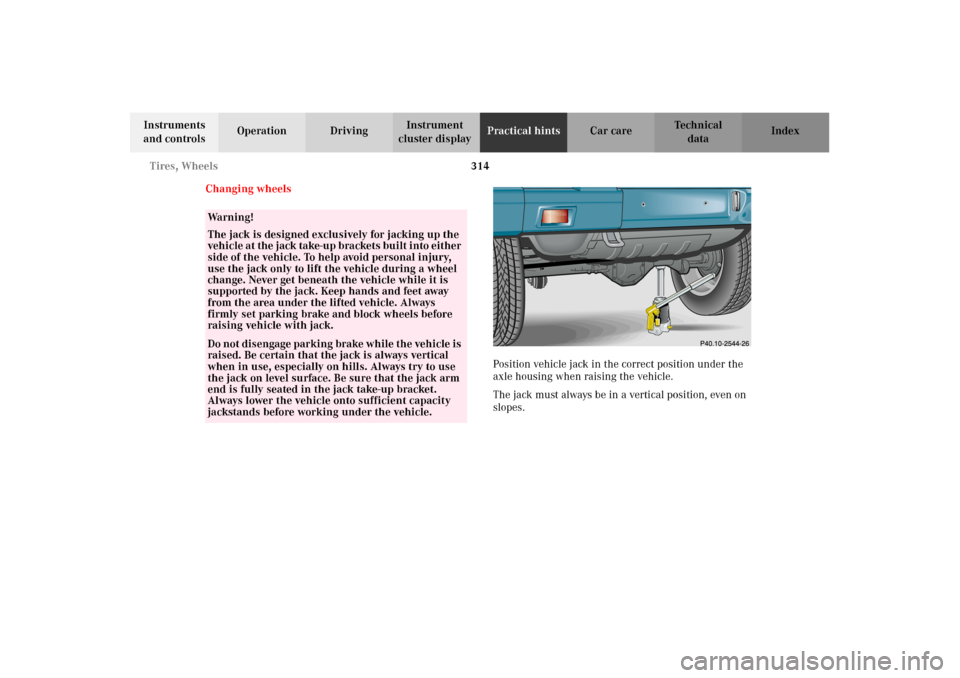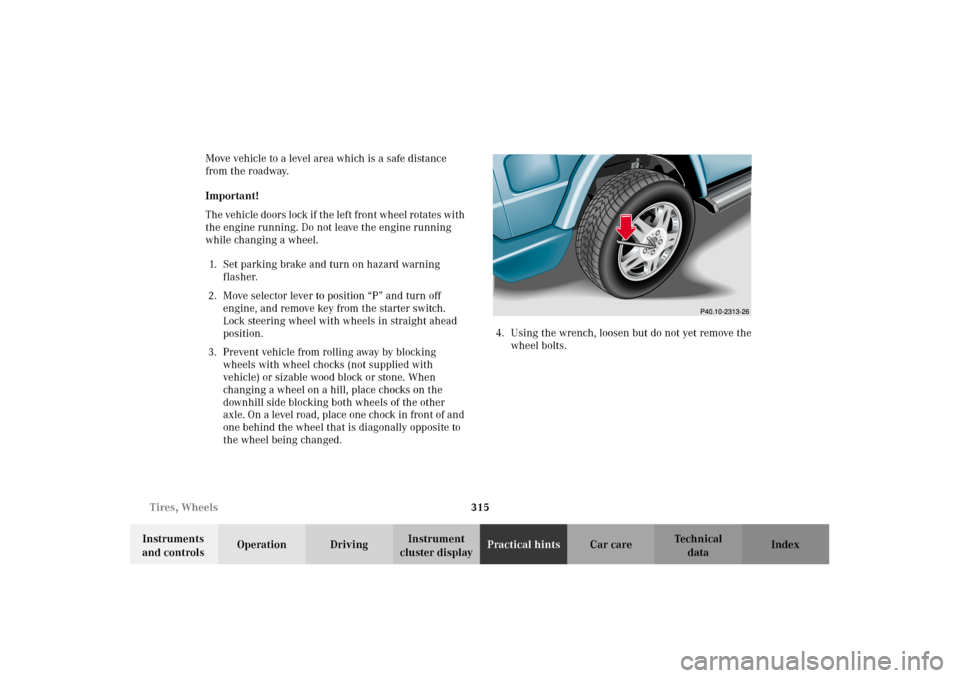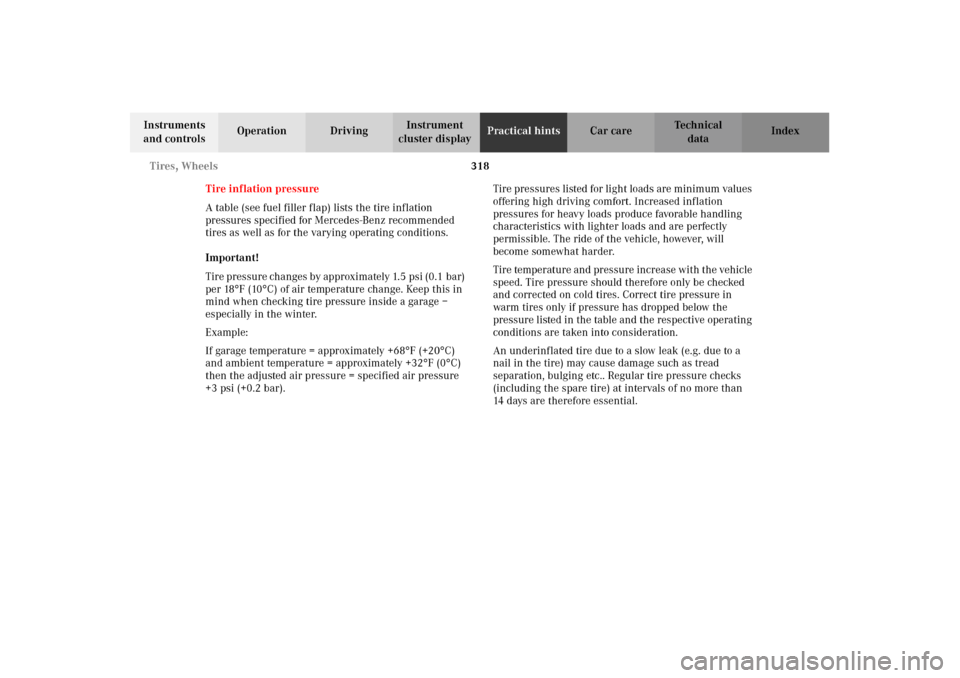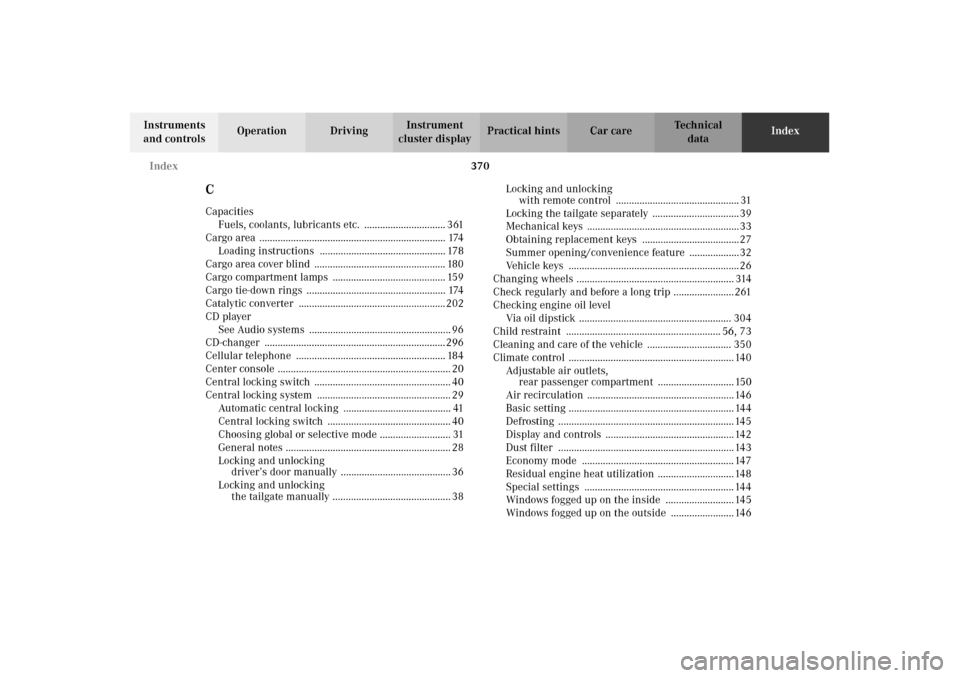Page 317 of 385

314 Tires, Wheels
Te ch n i c a l
data Instruments
and controlsOperation DrivingInstrument
cluster displayPractical hintsCar care Index
Changing wheels
Position vehicle jack in the correct position under the
axle housing when raising the vehicle.
The jack must always be in a vertical position, even on
slopes.
Wa r n i n g !
The jack is designed exclusively for jacking up the
vehi c le a t the j ack take-up b ra ckets b ui lt i nto eit her
side of the vehicle. To help avoid personal injury,
use the jack only to lift the vehicle during a wheel
change. Never get beneath the vehicle while it is
supported by the jack. Keep hands and feet away
from the area under the lifted vehicle. Always
firmly set parking brake and block wheels before
raising vehicle with jack.Do n ot d is engage parki n g brake w hil e t he vehi c le i s
raised. Be certain that the jack is always vertical
when in use, especially on hills. Always try to use
the jack on level surface. Be sure that the jack arm
end is fully seated in the jack take-up bracket.
Always lower the vehicle onto sufficient capacity
jackstands before working under the vehicle.
J_G463.book Seite 314 Mittwoch, 19. September 2001 8:06 08
Page 318 of 385

315 Tires, Wheels
Te ch n i c a l
data Instruments
and controlsOperation DrivingInstrument
cluster displayPractical hintsCar care Index Move vehicle to a level area which is a safe distance
from the roadway.
Important!
The vehic le door s lock if t he lef t f ron t wheel r otate s with
the engine running. Do not leave the engine running
while changing a wheel.
1. Set parking brake and turn on hazard warning
flasher.
2. Move selector lever to position “P” and turn off
engine, and remove key from the starter switch.
Lock steering wheel with wheels in straight ahead
position.
3. Prevent vehicle from rolling away by blocking
wheels with wheel chocks (not supplied with
vehicle) or sizable wood block or stone. When
changing a wheel on a hill, place chocks on the
downhill side blocking both wheels of the other
axle. On a level road, place one chock in front of and
one behind the wheel that is diagonally opposite to
the wheel being changed.4. Using the wrench, loosen but do not yet remove the
wheel bolts.
J_G463.book Seite 315 Mittwoch, 19. September 2001 8:06 08
Page 321 of 385

318 Tires, Wheels
Te ch n i c a l
data Instruments
and controlsOperation DrivingInstrument
cluster displayPractical hintsCar care Index
Tire inflation pressure
A table (see fuel filler flap) lists the tire inflation
pressures specified for Mercedes-Benz recommended
tires as well as for the varying operating conditions.
Important!
Tire pressure changes by approximately 1.5 psi (0.1 bar)
per 18
°F (10
°C) of air temperature change. Keep this in
mind when checking tire pressure inside a garage –
especially in the winter.
Example:
If garage temperature = approximately +68
°F (+20
°C)
and ambient temperature = approximately +32
°F (0
°C)
then the adjusted air pressure = specified air pressure
+3 psi (+0.2 bar).Tire pressures listed for light loads are minimum values
offering high driving comfort. Increased inflation
pressures for heavy loads produce favorable handling
characteristics with lighter loads and are perfectly
permissible. The ride of the vehicle, however, will
become somewhat harder.
Tire temperature and pressure increase with the vehicle
speed. Tire pressure should therefore only be checked
and corrected on cold tires. Correct tire pressure in
warm tires only if pressure has dropped below the
pressure listed in the table and the respective operating
conditions are taken into consideration.
An underinflated tire due to a slow leak (e.g. due to a
nail in the tire) may cause damage such as tread
separation, bulging etc.. Regular tire pressure checks
(including the spare tire) at intervals of no more than
14 days are therefore essential.
J_G463.book Seite 318 Mittwoch, 19. September 2001 8:06 08
Page 373 of 385

370 Index
Te ch n i c a l
data Instruments
and controlsOperation DrivingInstrument
cluster displayPractical hints Car careIndex
CCapacities
Fuels, coolants, lubricants etc. ............................... 361
Cargo area ....................................................................... 174
Loading instructions ................................................ 178
Cargo area cover blind .................................................. 180
Cargo compartment lamps ........................................... 159
Cargo tie-down rings ..................................................... 174
Catalytic converter ........................................................ 202
CD player
See Audio systems ...................................................... 96
CD-changer ..................................................................... 296
Cellular telephone ......................................................... 184
Center console .................................................................. 20
Central locking switch .................................................... 40
Central locking system ................................................... 29
Automatic central locking ......................................... 41
Central locking switch ............................................... 40
Choosing global or selective mode ........................... 31
General notes ............................................................... 28
Locking and unlocking
driver’s door manually .......................................... 36
Locking and unlocking
the tailgate manually ............................................. 38Locking and unlocking
with remote control ............................................... 31
Locking the tailgate separately ................................. 39
Mechanical keys ..........................................................33
Obtaining replacement keys .....................................27
Summer opening/convenience feature ...................32
Vehicle keys ................................................................. 26
Changing wheels ............................................................ 314
Check regularly and before a long trip ....................... 261
Checking engine oil level
Via oil dipstick .......................................................... 304
Child restraint ........................................................... 56, 73
Cleaning and care of the vehicle ................................ 350
Climate control ............................................................... 140
Adjustable air outlets,
rear passenger compartment ............................. 150
Air recirculation ........................................................ 146
Basic setting ............................................................... 144
Defrosting ................................................................... 145
Display and controls ................................................. 142
Dust filter ................................................................... 143
Economy mode .......................................................... 147
Residual engine heat utilization ............................. 148
Special settings ......................................................... 144
Windows fogged up on the inside .......................... 145
Windows fogged up on the outside ........................ 146
J_G463.book Seite 370 Mittwoch, 19. September 2001 8:06 08